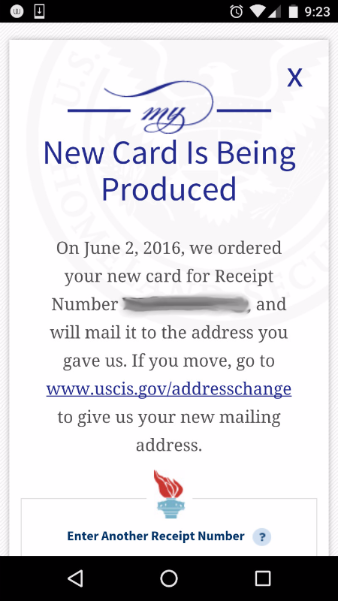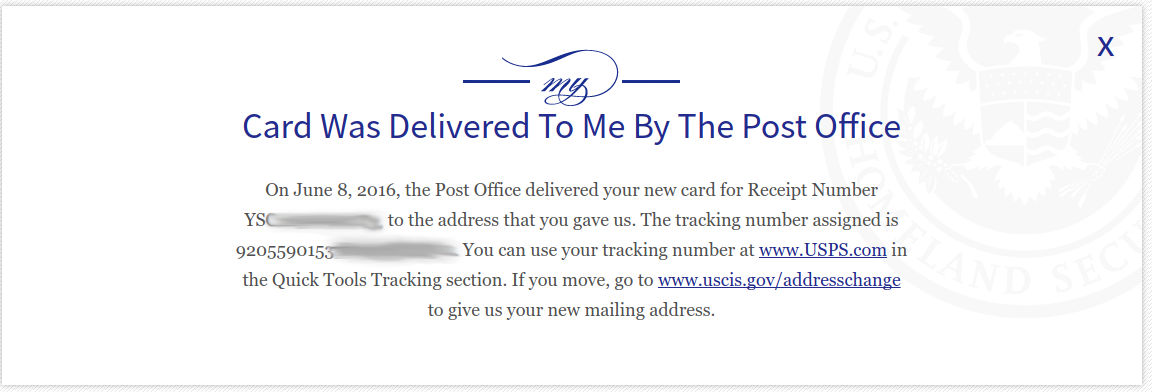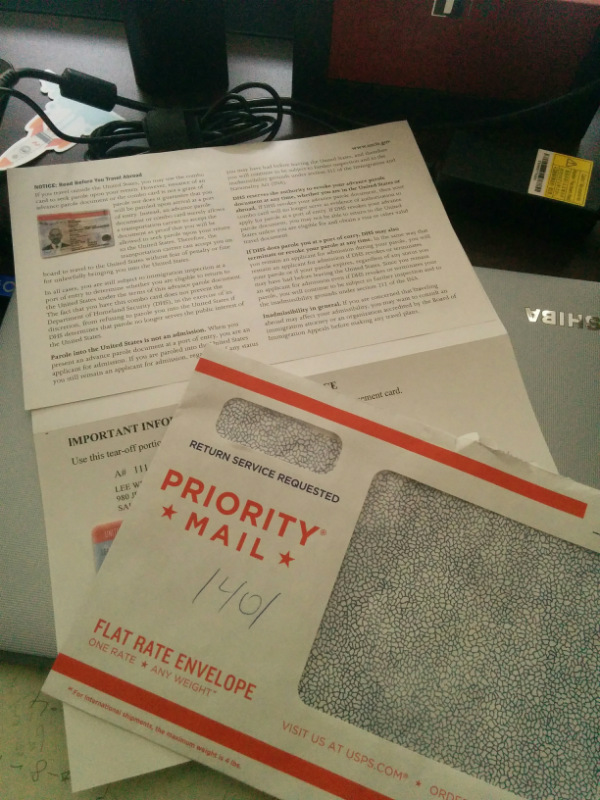Recently I’ve received my EAD (Employment Authorization Document). I feel like it’s a process amongst peers that everyone is familiar with, yet not completely sure of. There are a ton of helpful resources online, but when I looked for the actual process students on an F-1 visa go through when applying for an EAD, no one really had photos or a documentation. I found myself constantly refreshing the status checker on the USCIS website (even after signing up for mobile and email alerts, unsure of the next steps).
Hence I thought I’d share my entire process of applying, waiting and getting an EAD, or otherwise informally known as the OPT (optional practical training) card. Hopefully someone would find this useful and have an idea of what the entire process from applying to receiving it will be like, with all the status changes. Let’s start with a few FAQs, because that’s how people like reading things nowadays.
Obligatory Disclaimer: Information in this article should not be taken as absolute truth or legal advice and are only my personal experiences and to the best of my understanding, which might still be false, thus, should only be used as just another reference. (I’m not that good with writing disclaimers, but you get the point, I won’t be held responsible or liable and don’t sue me if anything goes wrong or is factually incorrect.)
What is an EAD?
Chances are if you’re into reading this article you would have an idea of what an EAD is, but for the others, especially the freshmen and sophomores of college, it’s a document that you apply for around graduation time to gain approval from USCIS to work in the United States. If you’re a US Citizen or have a green card, this doesn’t concern you, it’s only for the international students. This article is targeted to those with an F-1 student visa, though I’m sure people who aren’t on an F-1 visa might require this to work in the US.
Is it a visa?
That was a question I had before I read up extensively on this, nope. It is not a visa. Upon receiving your EAD, you’re still on an F-1 visa, and this status doesn’t change until your OPT duration expires, that is, the right for you to work in the US to gain training and experience after graduating for about 1 to 3 years. After which you’d need to apply (and get) a H1B work visa, or a green card/permanent resident.
What’s the difference between an EAD/OPT/I-765 and er, CPT?
OPT (F-1 OPT) is a period students on an F-1 visa can work without a work visa. Students who graduate from a university in the United States will qualify for OPT, most of the time. OPT usually starts after graduation (post-completion OPT), though for some cases students go on OPT time before graduation (pre-completion OPT).
You need an EAD/I-765 to lawfully start working on OPT, that is a document from USCIS giving you the authorization to go on OPT and work in the United States.
A CPT is curricular practical training, which is not OPT, it allows a student to work part time/full time (with restrictions you should be aware of) while still in college, such as for an internship. At time of writing full time (more than 20 hours a week) CPT can go up to 12 months without affecting OPT (more than that and you’ll lose OPT time), while there isn’t a limit for part time CPT.
How do I apply for OPT? Pls.
I’m mentioning this and also intentionally leaving it out so that you’ll be forced to go to your university’s international student website to check it out. Every university is different. I’ll link my alma-mater’s site here and requirements here. The gist of it is you’ll need to fill in a few forms, and provide quite a bit of documentation to show that you are eligible for OPT. You’ll have to pay an exact amount of $380 at time of writing. You’ll also need a new I-20 from the office, which you’ll send a copy to USCIS as well in your application, then mail it.
There’s a ton of resources on the Internet and they’ll most probably explain it way better than I can.
Typically the entire process from USCIS receiving your document until you receive the USCIS card takes about 3 months.
Now let’s assume you’ve already sent in your application, let’s talk about what happens next.
1. After applying, you’ll receive a ‘Case was Received’ notification.
This will be a notice that USCIS has already received your application, and they’ll mail you a paper receipt indicating so. If you applied with a G-1145 form, which my university recommended but I know some universities that did not. They’ll send you an email to notify you. The receipt number (and paper receipt) is important, don’t toss it like your other receipts. It might be in the format of YSCXXXXXXXXXX where X’s are numbers. If you go to the USCIS website and check your status with this tool, you’ll see something like the following, except it’ll say Form I-765 instead and that they mailed the receipt notice to your address:
*Photo credit to RedBus2us, I didn’t manage to find my screenshot of this, despite I was stuck longest in this stage and constantly refreshing the page.
I also recommend signing up for an account, it’ll enable automatic email and mobile notifications (though in my experience email notifications on status changes happen faster than mobile), so you won’t have to refresh the page in anticipation everyday like a mad person, if you’re waiting to receive it ASAP, that is.
2. After some time, the status will change to New Card Is Being Produced.
As I applied for the EAD on April 1st (ha), and it was received on April 6th, which I received an email notification thanks to the G-1145, I was stuck in the previous ‘Case was received’ status for about 2 months. I have had friends stay in that phase for longer than 90 days. So don’t panic if yours isn’t immediate, it really depends on a lot of factors. USCIS advises to only perform a case inquiry if the status hasn’t changed in 90 days (3 months).
To my surprise, on June 2nd, which was ~2 months after USCIS has received my case, it changed to this:

If you got this status change, the ball starts rolling! It won’t be long before you’ll get it.
3. Card Was Mailed to Me
On June 6th (4 days after the previous status change), I received this status change on the website, something you’ll see:

Of course, this will depend on many factors such as business days, holidays etc.
4. Finally, Card Was Delivered.
Within 2 days, I checked my mail box and found this Priority Mail envelope. To my surprise, it was the EAD card. This was before the status changed for one final time to this.

This was what came in the mailbox.

I took a photo of my EAD card wanting to edit my personal information out, but then I found this photo credits to Immihelp, so I’ll save myself some time by just using their sample.

and just for laughs…

So my timeline for the entire process was:
- Sent in application materials on April 1st
- USCIS received my case on April 6th (5 days later)
- My status changed to ‘card being produced’ on June 2nd. (2 months later)
- Card Was Mailed out on June 6th. (4 days later)
- Received my EAD card on June 7, with a status update on June 8 (2 days later)
This brings my entire process to a total of 2 months and 6 days. Don’t be worried if your card doesn’t follow this timeline, USCIS has a lot of cases to deal with, so it depends on the number of applications, I know of friends who graduated last december and waited almost five months for it, while others received it less than a month. Applying ASAP (90 days before graduation) is never a bad thing, right?
What should I do now if my status hasn’t changed after 75 days?
As my friend Su Ann has mentioned to me after publishing a draft of this, if after 75 days if status hasn’t changed you can ask to expedite if you need the card urgently. This also depends on the number of applicants; such as if you apply late April or May, it will take longer for the card to process due to the increased number of applicants.
Additional Advice if you want it.
- Be sure to read the instructions posted by your University’s Internation Student and Scholar Services website, every university has a slightly different way of approaching it. Check with them and meet with an advisor to be sure of what you need to sdo.
- Apply as soon as you can, which is 90 days (3 months) before the end of your degree program.
- If you have plans to relax before you start work, you can set a start date as late as 60 days from your program end date. This would maximize your OPT work period.
- You can apply for an EAD without any job offer. In fact most people do this and then use up to 90 days from the OPT start date to secure a job.
- I’ve read articles about how to expedite the processing of the EAD, which contain advice not given by my universities international student services, so it might be a good idea to check with them, I personally can’t vouch from experience whether the tips I found online work, such as attaching the offer letter when applying. I didn’t manage to expedite my request when I attempted to a month in of my application.
- All initial EADs have a duration of 1 year, regardless of STEM or non-STEM majors. It’s the extension that follows (which you’ll have to apply for separately) that will differ.
- Again, always check with your school’s international office! They’re the experts, not some random guy on the Internet with a nice looking blog.
- The University of Washington has a well written comprehensive guide on applying for an OPT and the process if you feel your University’s one is lacking.
What are your experiences? Or questions maybe others could help? Lastly do let me know if this helped, or share it with someone else who’s going through (or will go through) the motions of applying for the EAD!
Edited June 28, 2016: I previously made an error on the OPT start and end dates. One can start 90 days before program end date, and as late as 60 days after program end date. Here’s info straight from the USCIS page, (thank you Felicity for pointing it out):
How do I apply for F-1 OPT?: Once you receive a recommendation for post-completion OPT from your Designated School Official (DSO) to pursue OPT, you must apply for an employment authorization document (EAD) with USCIS within 30 days. Additionally, you may file up to 90 days prior to your program end-date and not later than 60 days after your program end date.

